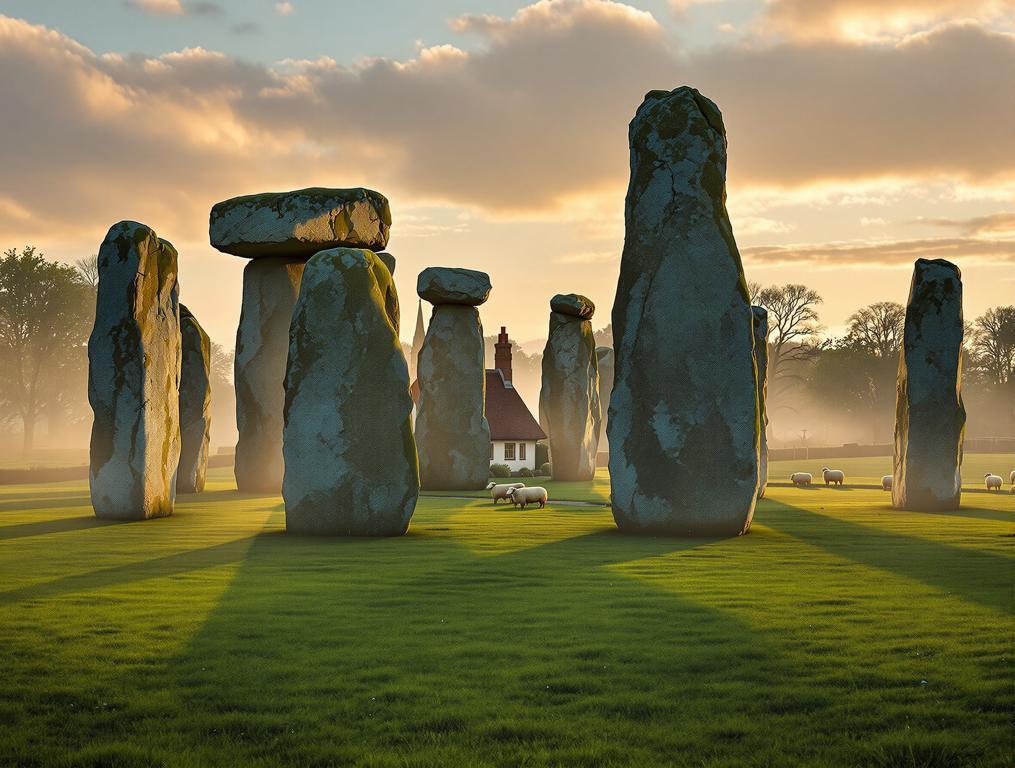I stand inside a prehistoric stone circle that envelops an entire English village. The morning mist wraps around ancient megaliths while a local resident casually walks her dog between 40-ton stones as if they’re just ordinary street corners. This is Avebury, home to the world’s largest stone circle at 11.5 hectares (28.5 acres). Unlike its famous neighbor Stonehenge, which gets the Instagram glory, this 5,000-year-old monument literally surrounds a living community of fewer than 600 residents.
A church bell chimes from the center of the village as I trace my hand along a sarsen stone that stands silent sentinel over the village pub. The juxtaposition is jarring – ancient monument meets everyday rural English life.
The 11.5-hectare monument where everyday life happens inside ancient mysteries
Avebury’s stone circle isn’t just bigger than Stonehenge – it’s four times larger than its famous counterpart’s inner circle. The difference? Here, you can actually touch the stones that prehistoric hands positioned millennia ago.
Most visitors to England rush to Stonehenge, 25 miles south, without realizing they’re missing something even more extraordinary. While those crowds pay admission to view cordoned-off stones from a distance, Avebury offers unrestricted access to a monument that’s both larger and older.
“When I moved here, I thought living inside a stone circle would feel special,” a village shopkeeper tells me as she arranges postcards. “Twenty years later, I still feel that tingle when I walk home at dusk.”
The outer stone circle originally featured nearly 100 standing megaliths, though many were destroyed or buried during medieval times. The National Trust and English Heritage have worked to restore what remains, creating an experience that feels authentically raw compared to other English heritage sites that feel more curated.
Why Stonehenge gets the fame while Avebury offers deeper immersion
What makes Avebury extraordinary isn’t just its size but its integration with everyday life. The village pub, The Red Lion, sits at the center of the monument – likely the only bar in the world located inside a prehistoric stone circle.
Visitors who’ve experienced both sites often find Avebury more spiritually moving precisely because it lacks the commercial infrastructure of its famous neighbor. Here, sheep graze among the stones, creating a pastoral scene that has remained largely unchanged for centuries.
“There’s something about walking these ancient paths knowing generations have done the same. At Stonehenge you’re kept at a distance. Here, you become part of the monument’s continuing story.”
The site forms part of a larger sacred landscape that includes Silbury Hill – Europe’s largest artificial prehistoric mound – and West Kennet Long Barrow, a 5,650-year-old burial chamber you can actually enter. This connection to other monuments creates a landscape of discovery similar to cliff villages in Europe where nature and human history intertwine.
Living among giants: The village where grocery shopping means passing 40-ton megaliths
Avebury’s residents have a uniquely intimate relationship with ancient history. Gardens back onto neolithic earthworks, and the local post office sits beside stones that have stood for millennia.
The museum at Alexander Keiller Museum houses artifacts discovered during excavations, including pottery and tools that offer glimpses into the lives of those who built this extraordinary place. What’s remarkable is how the spiritual significance of the site continues to draw modern pilgrims, particularly during solstice celebrations.
For the best experience, arrive at dawn or dusk when the stones cast long shadows across the landscape. The entire circuit around the outer bank stretches nearly one mile, offering different perspectives of both monument and village.
Visit in early morning to avoid tour buses, and wear sturdy shoes – the dew-covered grass can be slippery. The National Trust car park charges a small fee, but members park free.
Summer 2025: The perfect time to experience Avebury’s accessible wonders
While the summer solstice has just passed, these warmer months offer the perfect conditions to explore Avebury’s landscape. The surrounding walking paths connect to ancient pilgrimage routes that wind through the Wiltshire countryside.
The wildflowers peak in July, creating a carpet of color against the stark white chalk hills. This natural display draws photographers seeking to capture the stone circles framed by summer blooms.
As I watch the evening light transform the stones from white to gold, I understand why prehistoric builders chose this spot. There’s a presence here that transcends time – something that can’t be replicated at more carefully managed sites.
My daughter Emma once asked why some places feel special. Standing in Avebury’s ancient circle as village lights begin to twinkle between megalithic silhouettes, I finally have my answer. Some places never stop being sacred, even when surrounded by the beautiful mundanity of everyday life.
